|
Railway Towns / Deloraine Flour Mill The story of the flour-milling experience in Deloraine is representative of what occurred in many small villages and towns across southwestern Manitoba. The first village sites were bypassed by the railway, and re-established. Railway facilities made it possible for those new towns to expand the range of services they were able to provide to nearby farmers, but new businesses were not always successful. When Old Deloraine’s buildings were moved to the railhead, it was proposed to move Sheppard’s mill as well. However, the lack of an adequate water supply at the new site made this plan unfeasible. The first settlements were located near water – they had to be. The railway companies made their decisions based on efficiency and cost of building the line. Eventually, the mill was sold for $150 to Messrs. Preston and McKay, who relocated the mill’s machinery to neighbouring Boissevain. 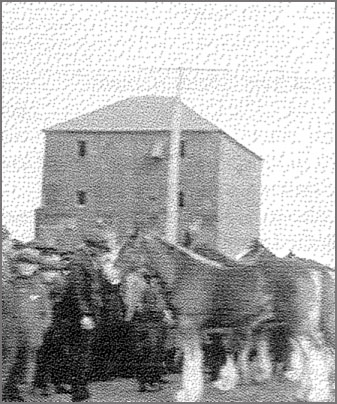 The first mill in the new town of Deloraine. 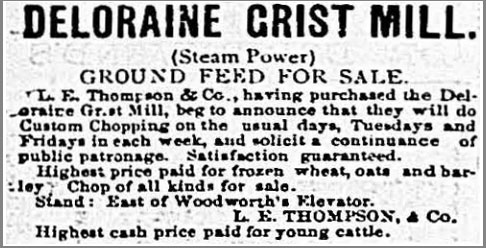 Deloraine TImes, May 9, 1889 An inquiry was received in November 1895 from the Ontario Milling and Manufacturing Company of Ottawa for a suitable mill site along the railway. Mr. Hughes from Leeds County, Ontario arrived in Deloraine to oversee the construction of a 42-foot, three-story building. The business was not a success and the mill functioned intermittently. It seemed unreasonable to residents that “after putting up a bonus, farmers should have to drive to Boissevain or elsewhere to get gristing done as they have been doing all summer.” The municipal council believed that they had spent enough on this disappointing venture and refused to pay the Ontario Milling Company their bonus in 1898. The mill ceased operations in February 1901. Then, as now, the idea of offering incentives and tax exemptions, to attract businesses doesn’t always work as planned. The first mill never really became viable, but town fathers didn’t give up hope. The Ontario Milling Company, as an absentee landlord, had never made the capital investments necessary to sustain it as a viable operation. The chronic water supply problem, which plagued the entire town of Deloraine, placed an extra strain on the mill operation. The Deloraine Board of Trade admitted that any plans for a new mill had to include financing to provide a water supply. The mill was dismantled and local citizens, led by the Board of Trade and the Farmers Elevator Company, began making plans for the construction of a more reliable flour mill at Deloraine. 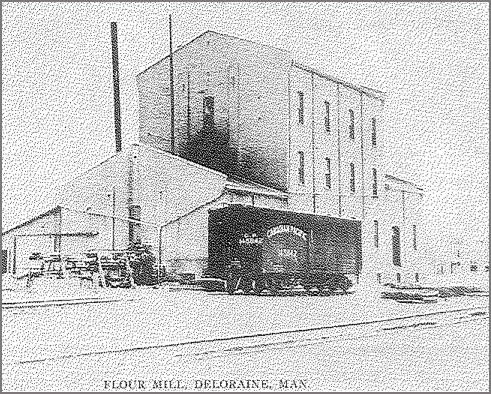 The second mill In 1907 The Deloraine Milling Co. Pres. was formed. A committee was arranged to ask the Town Council for an exemption from taxes. The formation of a joint stock company was an attractive alternative to the bonusing method used previously. Now the local investors had direct control over the operation of the firm and avoided a reliance on an unknown independent operator who might ignore local needs. Contracts were let and the mill went into operation immediately The flour mill, warehouse and power plant were completed in November 1908. The Deloraine Town Council passed a by-law granting the mill a five-year tax exemption. For a number of years it did a good business in grinding flour and other products. The Deloraine Milling Company began advertising in early December for good milling wheat. A year later the mill was providing same day service and offering its own brand of flour, “Deloraine’s Best, made from No. 1 Northern, at $2.75 per sack. This flour was described as, “unbleached and unexcelled, a strong glutinous patent flour.” Despite patronage from the local market, making a profit was difficult. The mill operated only intermittently during 1909, but still showed a $500 profit. In 1910, the mill expanded, introducing its flour for sale in local stores and managing to turn a net profit of $27 dollars during that year. By spring 1913, carloads of flour were being shipped to other southern Manitoba towns, such as Lyleton and Crystal City. That fall the mill finally cleared its financial liabilities, and for the first time stockholders were issued stock certificates, an indication that the enterprise had finally achieved financial stability. In fall 1914 the mill was shipping Gold Nugget Flour, not only to the local market but also to the Belgian Relief Fund. Business boomed during World War I due to demands for flour in war-ravaged Europe. However, shortly after the war, the mill struggled to compete with the emerging corporate flour mills who were rapidly taking over the local and regional markets. Companies such as Ogilvies and Lake of the Woods could produce and market their products more cheaply than locally-produced flour, thus putting less cost efficient local mills out of business. The mill was not reopened until 1930, when the deepening Depression created a demand for custom milling from farmers who could no longer afford the fine varieties sold in local grocery stores. In that year the mill was renamed “Turtle Mountain Mill.” Soon the mill was producing and marketing Gold Nugget whole-wheat flour. The outbreak of World War II soon created a world-wide flour shortage. During the war and in the years immediately following, Deloraine flour was shipped to England, China and Italy. In 1947, the company had eight overseas contracts, shipping, through an export broker, flour in 25-car lots of 1000 bags each. This required the mill to operate 24 hours a day. These lucrative contracts came to an end in 1950 when the Canadian Wheat Board, under lobbying pressure from the corporate milling concerns, refused to supply wheat for milling purposes to the small milling firms. This policy effectively drove most small milling firms out of business. The operation was sold to Squire Seeds of Bottineau, North Dakota, in spring of 1951. The flour milling industry had once been the most important regional manufacturing business in Manitoba, but that was changing. Improved transportation links, competition from large national companies, and changing consumer habits were taking their toll on local businesses in general. Small-town mills were one of the casualties. The closure was a serious blow to the local economy. Cheese Factory Not much is known about the Deloraine Cheese Factory, but an item in the local paper in 1894 notes that: “5100 lbs. of milk were received at Deloraine Cheese factory on one day. Deloraine cheese was shown at the Winnipeg fair.” It would appear that cheese making, which appeared to be a logical way to add value to local products, and which had seemed to work well in the Ontario homeland, was not a winning idea the southwest corner. As with other locally made products, improved transportation brought all kinds of competition. Brickyard The first brickyard in the Turtle Mountain region was located near Whitewater. W. Barker was the operator and employed between thirty and forty men. A fellow by the name of Hyman was foreman. The product was said to be of excellent quality  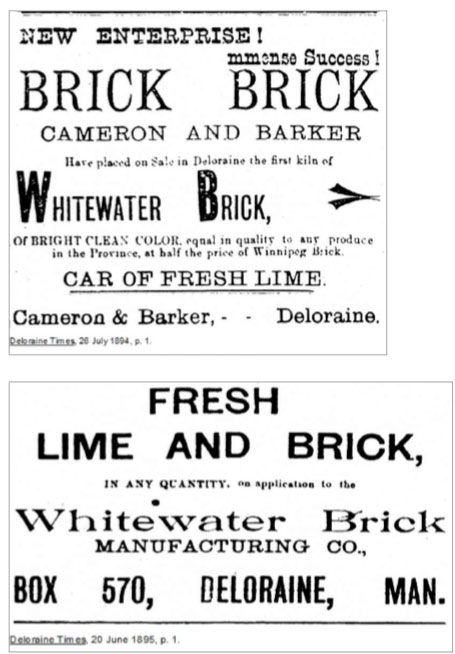 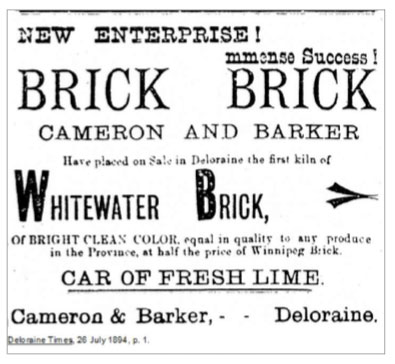 Several local buildings, including the Petersburg School, were built from these bricks. In 1894 the factory was sold to W. R. David and the brick machine moved to Deloraine next to the Racetrack. It was producing buy 1894, but once the initial settlement building boom was over was shut down. 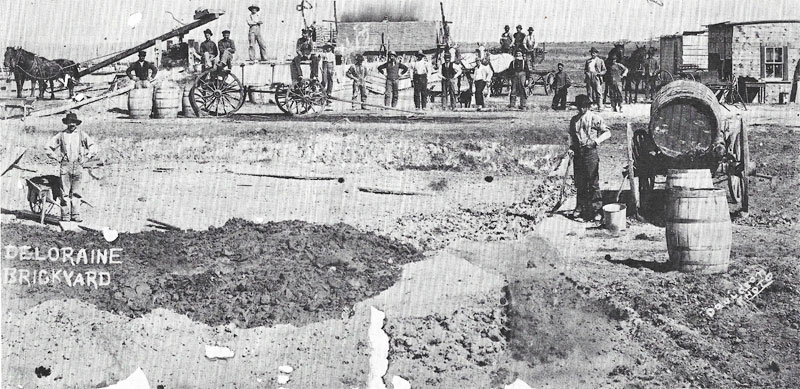 Brickyard in Deloraine
Carriage
Makers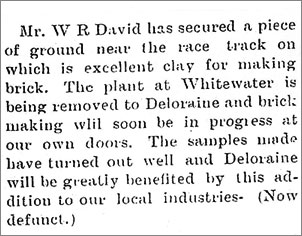 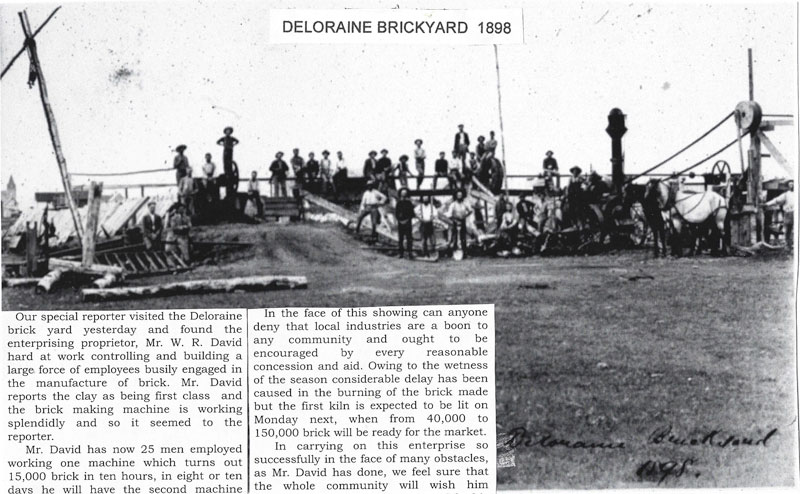 The Deloraine Carriage Factory run by Mr. B. Steele was for a short time “ one of the largest of its kind in the Province. Six men are employed, four blacksmiths, a woodworker and a painter. A second storey was added this spring to the shop for use as a carriage and paint shop. Trimming and leather work is done at Mr. Douglas' harness shop. The painting is of the highest quality, and six rigs were in various stages of finish.” 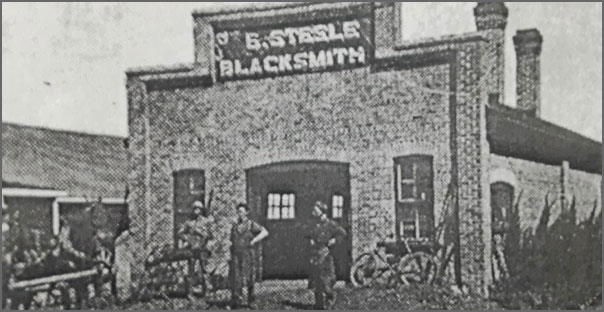 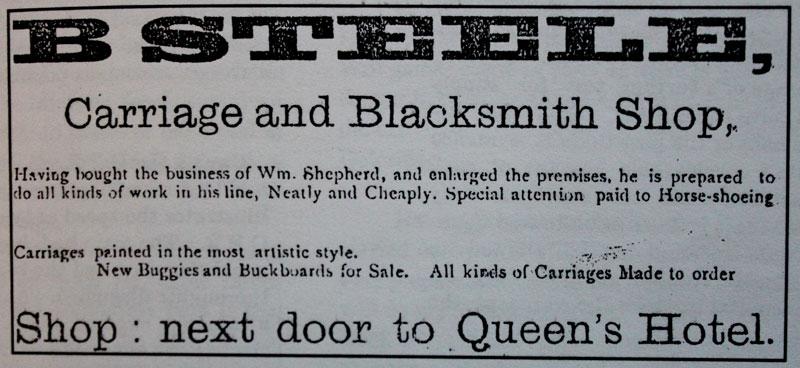 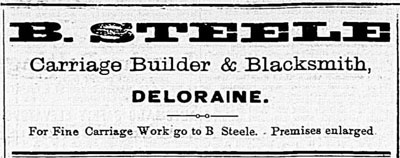 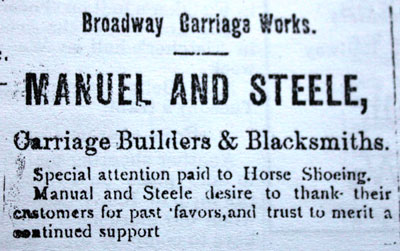 Deloraine Times, May 9, 1889 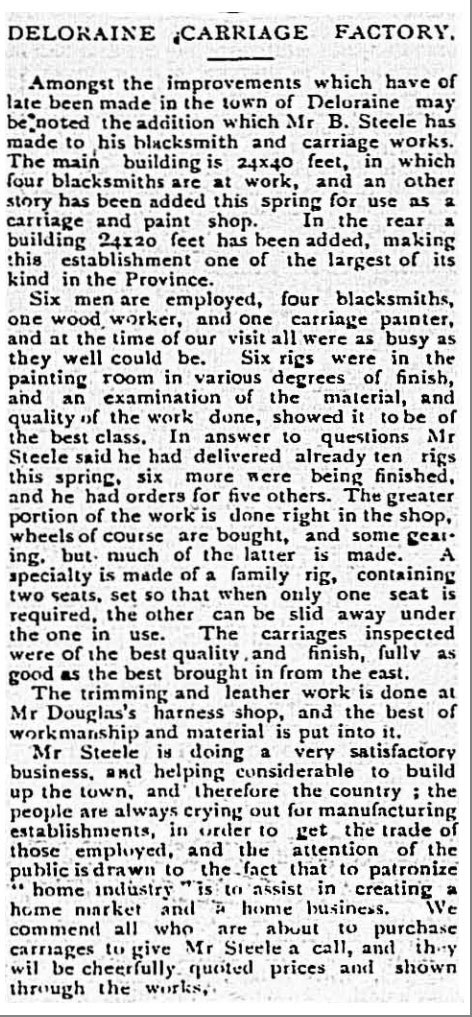 Deloraine Times, May 9, 1889 Clothing In a recap of items from the 1907 Deloraine Times we learn of this ad: Wanted- 8 to 10 girls at Harris' Clothing Factory to learn the tailoring business. Light work and learning free.  114 S. Railway (East) Earlier, in 1904 we learn that, “The Harris' Shoe Factory has been opened. “ Every village had a Tailor Shop and Millinery. Many of these businesses went far beyond mere alterations and fittings.  From the Deloraine Times in 1912. Harness Maker 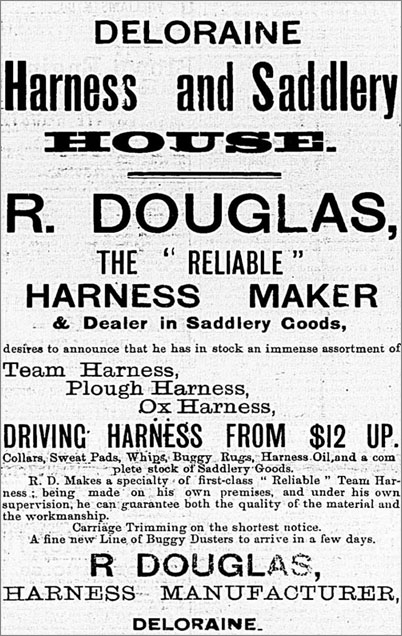 May 9, 1889 - Deloraine Times |


